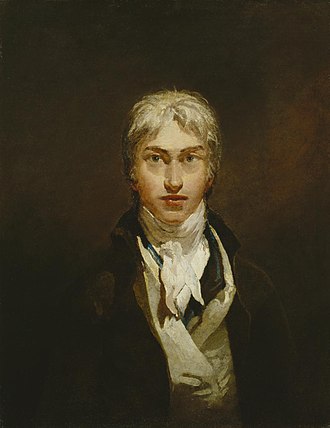Joseph Mallord William Turner‘s The Fighting Temeraire, tugged to her last berth to be broken up, is an oil painting by the English artist Joseph Mallord William Turner, painted in 1838 and exhibited at the Royal Academy in 1839.
The painting depicts the 98-gun HMS Temeraire, one of the last second-rate ships of the line to have played a distinguished role in the Battle of Trafalgar, being towed by a paddle-wheel steam tug towards its final berth in Rotherhithe in south-east London in 1838 to be broken up for scrap.
The painting hangs in the National Gallery, London, having been bequeathed to the nation by the artist in 1851. In a poll organised by BBC Radio 4's Today programme in 2005, it was voted the nation's favourite painting.

It was painted between 1838 and 1839, when the artist was at the height of his career. It hangs on National Gallery of London, voted as the UK favourite painting in a poll done by the BBC
Light and empire would be index words for this picture. Turner was known for his studies of the sea and the effects of light. Besides many nineteenth century locations in UK, he painted many of his pictures in and around the River Thames in London. The ship in the painting is about to be towed away from Sheerness to Rotherhithe for scrapping, and gave was trying to express the decline and fall of the old British Empire. The ship is depicted in a vivid light setting and the clouds are painted a bit foretelling and thickly onto the canvas. Bear in mind, the 98-gun ship Temeraire played a major role in Admiral Nelson's victory over the French at the Battle of Trafalgar in 1805. This ship had been service until the year 1838.
Facts about Joseph Mallord William Turner

Joseph Mallord William Turner RA (23 April 1775 – 19 December 1851), known contemporarily as William Turner, was an English Romantic painter, printmaker and watercolourist. He is known for his expressive colourisations, imaginative landscapes and turbulent, often violent marine paintings.
Turner was born in Maiden Lane, Covent Garden, London, to a modest lower middle-class family. He lived in London all his life, retaining his Cockney accent and assiduously avoiding the trappings of success and fame.
A child prodigy, Turner studied at the Royal Academy of Arts from 1789, enrolling when he was 14, and exhibited his first work there at 15. During this period, he also served as an architectural draftsman. He earned a steady income from commissions and sales, which due to his troubled, contrary nature, were often begrudgingly accepted. He opened his own gallery in 1804 and became professor of perspective at the academy in 1807, where he lectured until 1828, although he was viewed as profoundly inarticulate. He traveled to Europe from 1802, typically returning with voluminous sketchbooks.
Intensely private, eccentric and reclusive, Turner was a controversial figure throughout his career. He did not marry, but fathered two daughters, Eveline (1801–1874) and Georgiana (1811–1843), by his housekeeper Sarah Danby. He became more pessimistic and morose as he got older, especially after the death of his father, after which his outlook deteriorated, his gallery fell into disrepair and neglect, and his art intensified. He lived in squalor and poor health from 1845, and died in London in 1851 aged 76. Turner is buried in Saint Paul's Cathedral, London.
He left behind more than 550 oil paintings, 2,000 watercolours, and 30,000 works on paper. He had been championed by the leading English art critic John Ruskin from 1840, and is today regarded as having elevated landscape painting to an eminence rivalling history painting.
 About this site
About this site